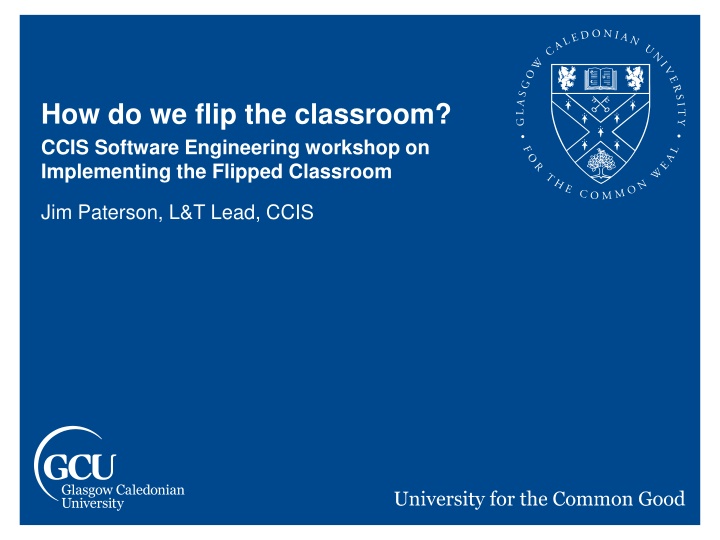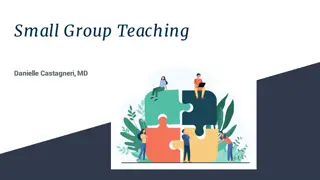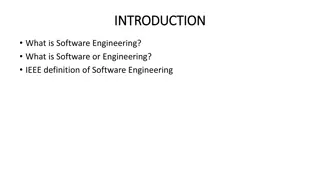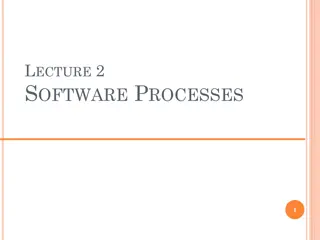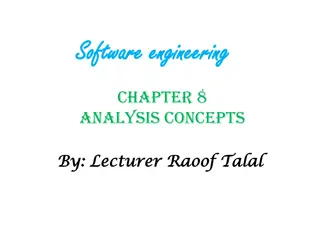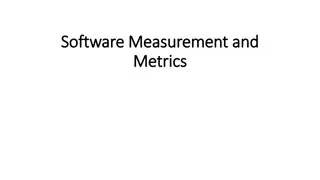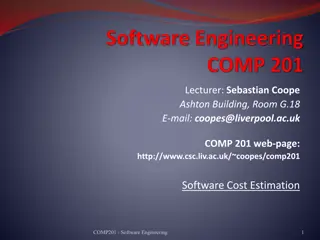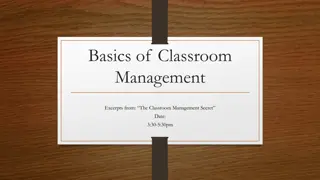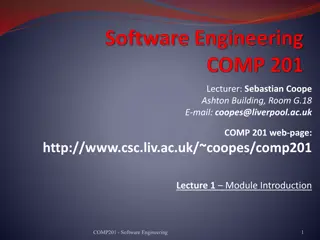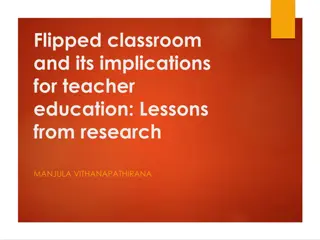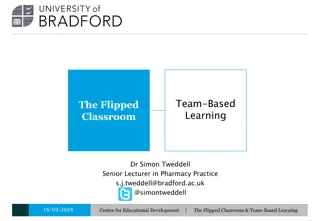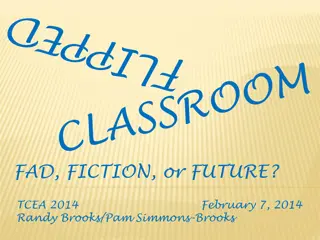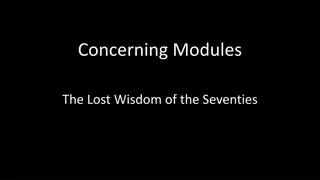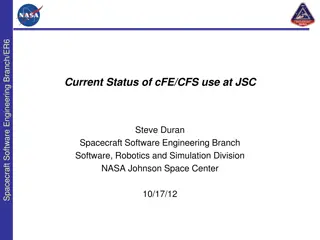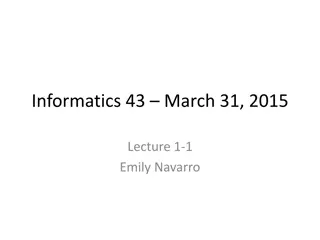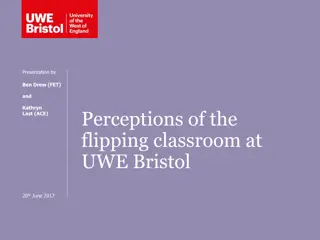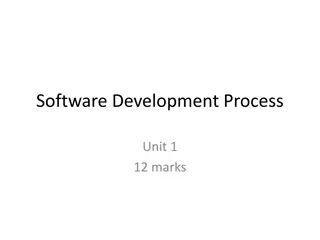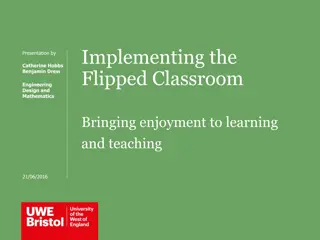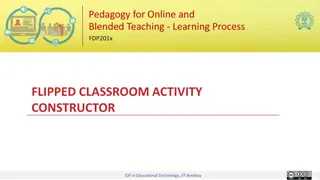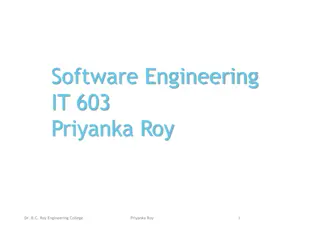Implementing the Flipped Classroom in Software Engineering Workshop
Explore the concept of flipping the classroom in software engineering through the eyes of Jim Paterson, focusing on motivation, implementation strategies, impact on students, and challenges faced. Discover the benefits of introducing learning material before class, allowing more time for in-depth understanding and collaborative problem-solving. Peer instruction and just-in-time teaching techniques are highlighted as effective tools for engaging students and promoting deeper cognitive thinking.
Download Presentation

Please find below an Image/Link to download the presentation.
The content on the website is provided AS IS for your information and personal use only. It may not be sold, licensed, or shared on other websites without obtaining consent from the author.If you encounter any issues during the download, it is possible that the publisher has removed the file from their server.
You are allowed to download the files provided on this website for personal or commercial use, subject to the condition that they are used lawfully. All files are the property of their respective owners.
The content on the website is provided AS IS for your information and personal use only. It may not be sold, licensed, or shared on other websites without obtaining consent from the author.
E N D
Presentation Transcript
How do we flip the classroom? CCIS Software Engineering workshop on Implementing the Flipped Classroom Jim Paterson, L&T Lead, CCIS
Contents Motivation Terminology Implementation Impact Challenges 2
What is the flipped classroom? Popularised by chemistry teachers Jon Bergman and Aaron Sams (Bergman & Sams 2012) Driven by a simple question: What is best for the students in my classroom? In a flipped approach, the conventional notion of classroom-based learning is inverted Students are introduced to the learning material before class Classroom time used to deepen understanding Discussion with peers and problem-solving activities facilitated by teachers 4
Why now? New delivery models in Computing @ GCU ALC Learning materials need to be online, significant development effort achieved and ongoing on this Classroom sessions with ALC Associate Lecturers GLA Work-based learning Limited time spent on campus, need to make best use for students of the sessions here Development of online learning materials offers alternatives to the traditional lecture-based approach 5
Peer Instruction and Just in Time Teaching Techniques used in the flipped classroom, predate the common usage of that term Described by Harvard Physics professor Eric Mazur in the late 1990s Mazur developed a model of peer instruction in which he provided material for students to prepare and reflect on before class Used class time to encourage deeper cognitive thinking via peer interaction and instructor challenge He called this just in time teaching (Crouch and Mazur 2001) 7
Peer Instruction (PI) Promotes classroom interaction to engage students and address difficult aspects of the material Typically structured around questions related to these aspects Provides opportunities for students to discuss concepts in class with peers Typically requires students to work collaboratively either in pairs or in larger groups In principle no limit to class size has been used with 100s of students in a class PI allows students to learn from each other Gives real-time feedback 8
Just in Time Teaching (JiTT) For PI to be most effective, students need to come to class with some basic understanding of the material JiTT structures students reading before class Delivers learning content, for example recorded lectures, online materials Provides feedback - for example, online quizzes provide feedback to students and to instructor Instructor can tailor the PI questions to target student difficulties Together, PI and JiTT help students and instructors monitor learning as it happens 9
PI and JiTT activities From: Just-in-time Teaching and Peer Instruction in the Flipped Classroom to Enhance Student Learning, Natalie Rowley and Jon Green 10
Implementing PI Session structured around short, conceptual multiple-choice questions (ConcepTests) After a brief presentation by the instructor, the focus shifts from the instructor to the student After 1 2 minutes of thinking, students commit to an individual answer Depending on results, instructor may ask students to turn to their neighbours and discuss their answers Students talk in pairs or small groups and are encouraged to find someone with a different answer The teaching staff circulates throughout the room to encourage productive discussions and guide student thinking After several minutes students answer the same ConcepTest again 12
Implementing PI From: Just-in-time Teaching and Peer Instruction in the Flipped Classroom to Enhance Student Learning, Natalie Rowley and Jon Green 13
When is discussion most effective? From Watkins & Mazur, justifies that discussion has most effect when 30-70% correct 14
Implementing PI - questions There are different types of question format which can be used in PI, for example: questions on general theories and definitions application of concepts in varying contexts questions which inter-relate different ideas predict the outcome questions on demonstrations questions for which there is a correct answer questions that stimulate discussion amongst students where there is no definitive answer 15
Implementing JiTT Students are expected to engage in advance with preparatory material that delivers the content that would traditionally be presented in lectures or in support of lectures, for example: Online content prepared by lecturer (e.g. ALC material) Recorded lectures Screencasts Video courses (e.g. Lynda, Pluralsight) Directed reading Also expected to engage with assignments in advance that direct the content classroom session 16
Implementing JiTT Quality of student discussion and learning in a PI classroom depends on the quality of the ConcepTests Questions must require higher-level thinking about a concept Questions must challenge students but allow them to reason to the answer with their existing knowledge. To choose the best ConcepTests, instructors need to gauge what concepts are causing student difficulties and what level of question is appropriate for their class By assigning JiTT assignments before class, instructors receive important feedback on their students knowledge and understanding of the material Learn what difficulties students have, what topics students are most apprehensive about, and what concepts students understand well 17
Impact 18
Impact of flipping Bergmann and Sams claim that flipping: Speaks the language of the students Helps busy students Helps struggling students Helps students of all abilities to excel Allows students to pause and rewind their teacher Increases student-teacher interaction Allows teachers to know their students better Increases student-student interaction Allows for real differentiation Changes classroom management 19
Evidence for impact Quite a lot of literature available on these techniques across a wide range of subjects (see for example Bishop & Verleger, 2013) Focus here on evidence relating to their use in our own discipline Summarising findings from a selection of papers published in Computer Science Education journals/proceedings Findings relate to: Student perceptions of value Fail rates Student evaluations 20
Student perception of value Multi-institutional study of PI by Porter et al. (2016), key findings: a supermajority of students in all studied classes liked and would recommend PI successful PI implementation requires that the instructor s motivations for using PI are clear to students 21
Impact on fail rates Earlier study by Porter et al. (2010), key findings: course fail rates are reduced 25-81% within-instructor fail rates reduced by 40-87% 22
Impact on student evaluations Liao et al. (2017), key findings: students value PI on course evaluations PI classes receive higher scores and have better scalability than non-PI classes 23
Student barriers Engagement, motivation, self-discipline Approach will not work if students are not prepared in advance of class Understanding of the approach, expectations Students need to know why we flip, how it works, and what they are expected to do Quality of preparatory content Difficult to motivate students to engage if learning materials are not carefully designed For example, many students will find it difficult to concentrate if these consist simply of recordings of hour- long lectures 25
Instructor barriers Unfamiliarity with the approach Time (and support) to prepare learning materials, JiTT assignments Time to design questions for PI sessions Classroom facilities, e.g. clickers Fear of student resistance/disengagement Organisational resistance 26
Useful resources http://www.peerinstruction4cs.org/ https://www.heacademy.ac.uk/enhancement/starter-tools/flipped- learning-0 https://intranet.birmingham.ac.uk/staff/teaching- academy/documents/public/eip-dec15/rowley.pdf http://flglobal.org/communityhome/ 27
References Watkins, J & Mazur, E. (2010) Just-in-Time Teaching and Peer Instruction , in Simkins, S.P. & Maier, M.H. (Eds.) Just-in-Time Teaching: Across the Disciplines, Across the Academy. Virginia, USA: Stylus Publishing, LLC. Bergmann, J. and Sams, A., 2012. Flip your classroom: Reach every student in every class every day. International Society for Technology in Education. Bishop, J.L. and Verleger, M.A., 2013, June. The flipped classroom: A survey of the research. In ASEE National Conference Proceedings, Atlanta, GA (Vol. 30, No. 9, pp. 1-18). Liao, S.N., Griswold, W.G. and Porter, L., 2017, March. Impact of Class Size on Student Evaluations for Traditional and Peer Instruction Classrooms. In Proceedings of the 2017 ACM SIGCSE Technical Symposium on Computer Science Education (pp. 375-380). ACM. Porter, L., Bailey Lee, C. and Simon, B., 2013, March. Halving fail rates using peer instruction: a study of four computer science courses. In Proceeding of the 44th ACM technical symposium on Computer science education (pp. 177-182). ACM. Porter, L., Bouvier, D., Cutts, Q., Grissom, S., Lee, C., McCartney, R., Zingaro, D. and Simon, B., 2016. A multi-institutional study of peer instruction in introductory computing. ACM Inroads, 7(2), pp.76-81. 28
